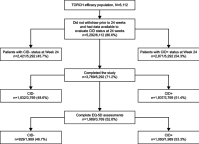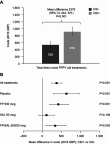Long-term cost and utility consequences of short-term clinically important deterioration in patients with chronic obstructive pulmonary disease: results from the TORCH study
- PMID: 31190781
- PMCID: PMC6524132
- DOI: 10.2147/COPD.S188898
Long-term cost and utility consequences of short-term clinically important deterioration in patients with chronic obstructive pulmonary disease: results from the TORCH study
Abstract
Purpose: Clinically important deterioration (CID) in chronic obstructive pulmonary disease (COPD) is a novel composite endpoint that assesses disease stability. The association between short-term CID and future economic and quality of life (QoL) outcomes has not been previously assessed. This analysis considers 3-year data from the TOwards a Revolution in COPD Health (TORCH) study, to examine this question. Patients and methods: This post hoc analysis of TORCH (NCT00268216) compared costs and utilities at 3 years among patients without CID (CID-) and with CID (CID+) at 24 weeks. A positive CID status was defined as either: a deterioration in forced expiratory volume in 1 second (FEV1) of ≥100 mL from baseline; or a ≥4-unit increase from baseline in St George's Respiratory Questionnaire (SGRQ) total score; or the incidence of a moderate/severe exacerbation. Patients from all treatment arms were included. Utility change was based on the EQ-5D utility index. Costs were based on healthcare resource utilization from 24 weeks to end of follow-up combined with unit costs for the UK (2016 GBP), and reported as per patient per year (PPPY). Adjusted estimates were generated controlling for baseline characteristics, treatment assignment, and number of CID criteria met. Results: Overall, 3,769 patients completed the study and were included in the analysis (stable CID- patients, n=1,832; unstable CID+ patients, n=1,937). At the end of follow-up, CID- patients had higher mean (95% confidence interval [CI]) utility scores than CID+ patients (0.752 [0.738, 0.765] vs 0.697 [0.685, 0.71]; difference +0.054; P<0.001), and lower costs PPPY (£538 vs £916; difference: £378 [95% CI: £244, £521]; P<0.001). The cost differential was primarily driven by the difference in general hospital ward days (P=0.003). Conclusion: This study demonstrated that achieving early stability in COPD by preventing short-term CID is associated with better preservation of future QoL alongside reduced healthcare service costs.
Keywords: EQ-5D; direct medical costs; resource utilization; utilities.
Conflict of interest statement
IN, NBG, and ASI are employees of GSK, and hold stock/shares in GSK. ASI is also an unpaid professor at McMaster University in Canada. MTD was employed by GSK at the time of this study. VFP and NR are employees of ICON Health Economics, who were contracted by GSK to conduct the study analysis. AB received consultancy fees from GSK and ICON Health Economics in relation to this study. AB and ICON employees were not paid for manuscript development. The authors report no other conflicts of interest in this work.
Figures




Similar articles
-
Health status in the TORCH study of COPD: treatment efficacy and other determinants of change.Respir Res. 2011 May 31;12(1):71. doi: 10.1186/1465-9921-12-71. Respir Res. 2011. PMID: 21627828 Free PMC article. Clinical Trial.
-
Long-term outcomes following first short-term clinically important deterioration in COPD.Respir Res. 2018 Nov 20;19(1):222. doi: 10.1186/s12931-018-0928-3. Respir Res. 2018. PMID: 30453972 Free PMC article. Clinical Trial.
-
Indacaterol/glycopyrronium versus salmeterol/fluticasone in the prevention of clinically important deterioration in COPD: results from the FLAME study.Respir Res. 2018 Jun 20;19(1):121. doi: 10.1186/s12931-018-0830-z. Respir Res. 2018. PMID: 29925383 Free PMC article. Clinical Trial.
-
Role of the fixed combination of fluticasone and salmeterol in adult Chinese patients with asthma and COPD.Int J Chron Obstruct Pulmon Dis. 2015 Apr 15;10:775-89. doi: 10.2147/COPD.S80656. eCollection 2015. Int J Chron Obstruct Pulmon Dis. 2015. PMID: 25926729 Free PMC article. Review.
-
Measuring disease activity in COPD: is clinically important deterioration the answer?Respir Res. 2020 Jun 2;21(1):134. doi: 10.1186/s12931-020-01387-z. Respir Res. 2020. PMID: 32487202 Free PMC article. Review.
Cited by
-
Characterising hospitalisation risk for chronic obstructive pulmonary disease exacerbations: Bedside and outpatient clinic assessments of easily measured variables.Chron Respir Dis. 2023 Jan-Dec;20:14799731231211852. doi: 10.1177/14799731231211852. Chron Respir Dis. 2023. PMID: 37934787 Free PMC article.
-
Economic Burden of Chronic Obstructive Pulmonary Disease: A Systematic Review.Tuberc Respir Dis (Seoul). 2024 Jul;87(3):234-251. doi: 10.4046/trd.2023.0100. Epub 2024 Feb 16. Tuberc Respir Dis (Seoul). 2024. PMID: 38361331 Free PMC article.
-
Clinically Important Deterioration Among Patients with Chronic Obstructive Pulmonary Disease (COPD) Treated with Nebulized Glycopyrrolate: A Post Hoc Analysis of Pooled Data from Two Randomized, Double-Blind, Placebo-Controlled Studies.Int J Chron Obstruct Pulmon Dis. 2020 Sep 29;15:2309-2318. doi: 10.2147/COPD.S267249. eCollection 2020. Int J Chron Obstruct Pulmon Dis. 2020. PMID: 33061349 Free PMC article. Clinical Trial.
-
Modified and simplified clinically important deterioration: multidimensional indices of short-term disease trajectory to predict future exacerbations in patients with chronic obstructive pulmonary disease.Ther Adv Respir Dis. 2020 Jan-Dec;14:1753466620977376. doi: 10.1177/1753466620977376. Ther Adv Respir Dis. 2020. PMID: 33357117 Free PMC article.
-
Comparation of predictive value of CAT and change in CAT in the short term for future exacerbation of chronic obstructive pulmonary disease.Ann Med. 2022 Dec;54(1):875-885. doi: 10.1080/07853890.2022.2055134. Ann Med. 2022. PMID: 35341416 Free PMC article.
References
-
- Global Initiative for Chronic Obstructive Pulmonary Disease (GOLD). Global strategy for the diagnosis, management and prevention of chronic obstructive pulmonary disease; 2019. Available from: https://goldcopd.org/wp-content/uploads/2018/11/GOLD-2019-v1.7-FINAL-14N.... Accessed December18, 2018.
-
- American Thoracic Society. The global burden of lung disease; 2014. Available from: http://foundation.thoracic.org/news/global-burden.php. Accessed August29, 2018.
Publication types
MeSH terms
Substances
Associated data
LinkOut - more resources
Full Text Sources
Medical
Research Materials
Miscellaneous

